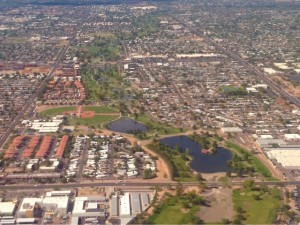View Source | July 22, 2015

Extreme weather events - like the rain and subsequent floods in the Phoenix metropolitan area in September 2014 - are occurring more frequently and can cripple crucial infrastructure that enables transit, electricity, water and other services. To tackle these challenges and change the way we think about urban infrastructure, the National Science Foundation awarded a transdisciplinary team of three ASU researchers $12 million to lead the international Urban Resilience to Extreme Weather-Related Events Sustainability Research Network (UREx SRN).
Anthropologist Charles Redman, ecologist Nancy Grimm and engineer Mikhail Chester will evaluate the social, ecological and technical systems related to infrastructure, recognizing the values of all stakeholders - from city decision-makers to the citizens who will use and be affected by infrastructure. They will also work to understand the natural environment in which infrastructure operates and evaluate available infrastructure technology. The result will be a suite of tools supporting the assessment and implementation of urban infrastructure that is resilient, tailored to a particular city and safe-to-fail - versus fail-safe, which can be a dangerous illusion.
“By bringing this all together, I think we may be able to really talk to people who build the future," says Redman. "From the first day of designing something like highways and power grids, we’re going to talk about how Earth’s systems work and how human institutions react. And we’re going to build for that. We’re going to build infrastructure to be more resilient and equitable and not just more efficient.”

